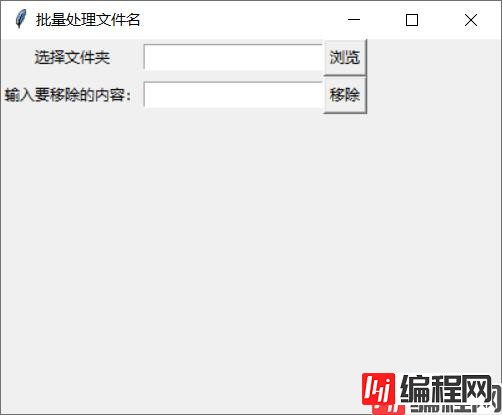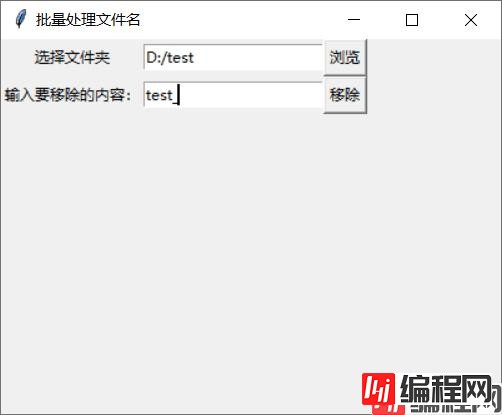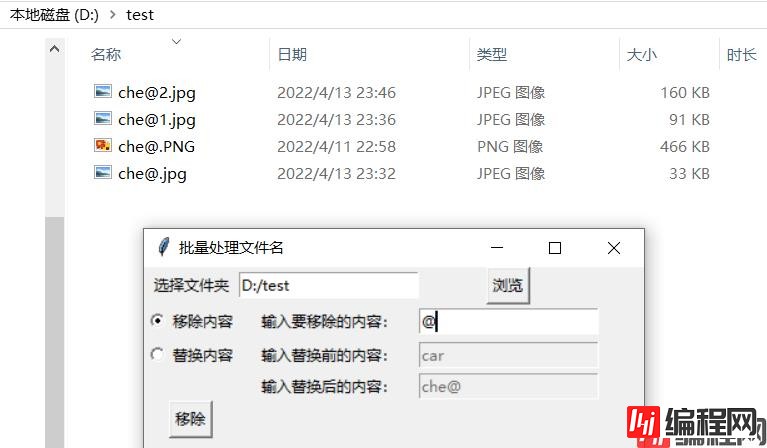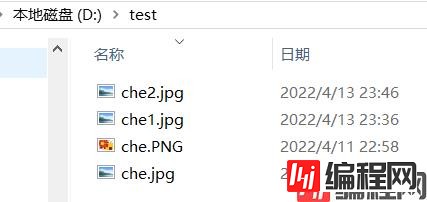Python 官方文档:入门教程 => 点击学习
用Python编写过批量修改文件名的脚本程序,代码很简单,运行也比较快,唯一美中不足之处是每次批量修改文件名时都需要执行以下步骤: 1)复制文件夹路径;2)打开脚本程序3)替换脚本中
用Python编写过批量修改文件名的脚本程序,代码很简单,运行也比较快,唯一美中不足之处是每次批量修改文件名时都需要执行以下步骤:
为了便于操作,最好还是弄成GUI界面,手动选择文件夹,这样程序也更通用。python中的GUI库很多,绝大部分都支持跨平台,其中安装Python时自带的GUI库是tkinter,本文就学习并创建基于tkinte的批量修改文件名程序。
本文涉及的知识点包括以下几个:
全部代码如下所示:
# coding=gbk
import tkinter as tk
import os
from tkinter.filedialog import askdirectory
def BrowseDri():
txtDirPath.set(askdirectory())
def BatchReplaceFileName():
path = txtDirPath.get()
strSign=txtRemovedContent.get()
files=os.listdir(path)
for onefile in files:
if onefile.find(strSign)<0:
continue
oldname=path+"\\"+onefile
newname=path+"\\"+onefile.replace(strSign,"")
os.rename(oldname,newname)
print(oldname,"====>",newname)
window=tk.Tk()
window.title('批量处理文件名')
window.geometry('600x400')
tk.Label(window,text='选择文件夹').grid(row=0,column=0)
txtDirPath=tk.StringVar()
tk.Entry(window,textvariable=txtDirPath).grid(row=0,column=1)
tk.Button(window,text='浏览',command=BrowseDri).grid(row=0,column=2)
tk.Label(window,text='输入要移除的内容:').grid(row=1,column=0)
txtRemovedContent=tk.StringVar()
tk.Entry(window,textvariable=txtRemovedContent).grid(row=1,column=1)
tk.Button(window,text='移除',command=BatchReplaceFileName).grid(row=1,column=2)
tk.mainloop()最后是程序运行效果,如下面几张截图所示:运行程序后,首先选择要批量处理的文件夹,然后设置文件名中要移除的内容,最后点击移除按钮批量处理文件名。




上文主要实现了批量移除文件名中的指定字符串,无法进行替换,本文在前面工作的基础上,增加批量替换文件名中指定字符串的功能。
新增的功能点不多,主要包括:
批量修改文件名程序的完整代码如所示:
# coding=gbk
import tkinter as tk
import os
from tkinter.filedialog import askdirectory
def BrowseDri():
txtDirPath.set(askdirectory())
def SetControlStatus():
mode=proceSSMode.get()
if(mode==1):
txtRemoved['state'] = 'normal'
txtBeforeReplaced['state'] = 'disabled'
txtAfterReplaced['state'] = 'disabled'
btnProcess['text']='移除'
elif mode==2:
txtRemoved['state'] = 'disabled'
txtBeforeReplaced['state'] = "normal"
txtAfterReplaced['state'] = 'normal'
btnProcess['text']='替换'
def BatchReplaceFileName():
path = txtDirPath.get()
mode=processMode.get()
if(mode==1):
strOldSign=txtRemovedContent.get()
strNewSign=""
elif mode==2:
strOldSign=txtBeforeReplactContent.get()
strNewSign=txtAfterReplactContent.get()
files=os.listdir(path)
for onefile in files:
if onefile.find(strOldSign)<0:
continue
oldname=path+"\\"+onefile
newname=path+"\\"+onefile.replace(strOldSign,strNewSign)
os.rename(oldname,newname)
print(oldname,"====>",newname)
window=tk.Tk()
window.title('批量处理文件名')
window.geometry('400x300')
tk.Label(window,text='选择文件夹').grid(row=0,column=0)
txtDirPath=tk.StringVar()
tk.Entry(window,textvariable=txtDirPath).grid(row=0,column=1)
tk.Button(window,text='浏览',command=BrowseDri).grid(row=0,column=2)
processMode =tk.IntVar()
tk.Radiobutton(window, text="移除内容", variable=processMode, value=1, command=SetControlStatus).grid(row=1,column=0)
tk.Label(window,text='输入要移除的内容:').grid(row=1,column=1)
txtRemovedContent=tk.StringVar()
txtRemoved=tk.Entry(window,textvariable=txtRemovedContent)
txtRemoved.grid(row=1,column=2)
tk.Radiobutton(window, text="替换内容", variable=processMode, value=2, command=SetControlStatus).grid(row=2,column=0)
tk.Label(window,text='输入替换前的内容:').grid(row=2,column=1)
txtBeforeReplactContent=tk.StringVar()
txtBeforeReplaced=tk.Entry(window,textvariable=txtBeforeReplactContent,state='disabled')
txtBeforeReplaced.grid(row=2,column=2)
tk.Label(window,text='输入替换后的内容:').grid(row=3,column=1)
txtAfterReplactContent=tk.StringVar()
txtAfterReplaced=tk.Entry(window,textvariable=txtAfterReplactContent,state='disabled')
txtAfterReplaced.grid(row=3,column=2)
processMode.set(1)
btnProcess=tk.Button(window,text='移除',command=BatchReplaceFileName)
btnProcess.grid(row=4,column=0)
tk.mainloop()最后是程序效果,如下图所示,选择指定文件夹,首先将文件夹中所有文件中的car字符串替换为che@,接着再移除文件名中的@字符。



到此这篇关于利用Python的tkinter模块实现界面化的批量修改文件名的文章就介绍到这了,更多相关Python tkinter批量修改文件名内容请搜索编程网以前的文章或继续浏览下面的相关文章希望大家以后多多支持编程网!
--结束END--
本文标题: 利用Python的tkinter模块实现界面化的批量修改文件名
本文链接: https://lsjlt.com/news/120152.html(转载时请注明来源链接)
有问题或投稿请发送至: 邮箱/279061341@qq.com QQ/279061341
2024-03-01
2024-03-01
2024-03-01
2024-02-29
2024-02-29
2024-02-29
2024-02-29
2024-02-29
2024-02-29
2024-02-29
回答
回答
回答
回答
回答
回答
回答
回答
回答
回答
0